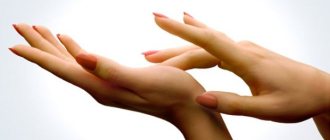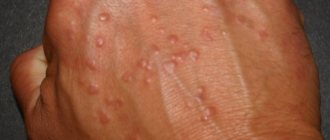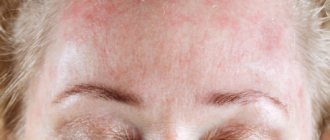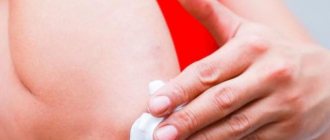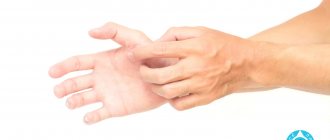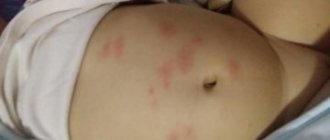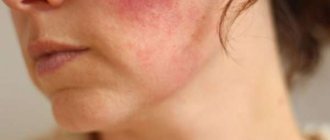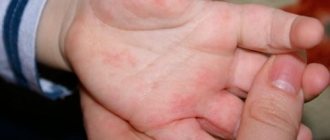Last update: 01/14/2020
Author of the article: pediatrician Valentina Razheva
In everyday life, we come into contact with a huge number of allergens, sometimes without even knowing it. And it goes without saying that the least protected areas of the skin take the blow. We are talking about the hands with which we wash dishes and do cleaning, grab snowballs in winter, forgetting about gloves, and rarely apply sunscreen in summer. But in addition to external irritants, there are many other reasons why allergies occur on the skin of the hands.
Causes of hand skin allergies
- Prolonged or regular contact of unprotected hands with household chemicals. Modern detergents contain active, strong chemicals, especially bleaches and plumbing cleaners.
- Allergies on the palms can also occur when using inappropriate cosmetics: low-quality soap or cream that contains allergenic components.
- Long-term use of medications, especially antibiotics.
- Some food products: nuts, milk, eggs, honey, citrus fruits and others.
- Unstable emotional state, stress, nervous exhaustion.
- Reaction to cold, sun and other weather conditions.
Types of hand allergies: how to recognize the cause from the symptoms?
Cracked palms, itching, burning, dryness, rash, red spots are the most common symptoms of hand allergies. The most painful and unpleasant manifestation of an allergic reaction is when the hands crack, swell, and may become covered with hard crusts and small ulcers. In this case, it is almost impossible to bend the fingers; every movement is accompanied by pain.
In fact, any manifestation of an allergy is the body’s reaction to various factors that provoke such a condition. In most cases, by the appearance of an allergy on the hands, it is possible to understand the cause of its occurrence.
- Allergies between the fingers most often develop as a result of contact with household chemicals. It appears almost instantly after direct contact of the chemical with the skin, accompanied by itching, red spots and even blisters. Since the fingers are often bent, the skin cracks in places where the rash occurs and wounds form.
- If you notice redness of your hands after going outside, which is accompanied by dry skin and soreness, it may be a hand allergy to the cold. Its external manifestations are similar to frostbite, and one of the main symptoms is pain. The skin in general looks unhealthy, thin, redness does not go away, even if you are already indoors.
- Redness, accompanied by swelling of the hands, the appearance of bubbles with a colorless liquid, similar to a burn, itching and burning of the skin: all these are alarming symptoms that can mean a serious disease - allergic dermatitis. Dermatitis develops with repeated contact with an allergen and eventually becomes chronic. The skin of the hands thickens, thickens, and constantly peels off: this condition is much more difficult to treat.
- The appearance of allergies on the crooks of the arms, elbows, as well as the presence of similar rashes on the legs and face are a reaction to poor nutrition. This may be excessive consumption of sugar, allergenic foods (for example, citrus fruits), or general food poisoning from low-quality products.
- Severely itchy pinpoint rashes on the hands indicate increased sensitivity to insect bites or burns from poisonous plants.
If these symptoms are accompanied by fever and swollen hands, then this is an allergy.
Please note that all symptoms of hand allergies can also accompany bacterial or fungal skin lesions, so before treatment, be sure to consult a dermatologist for an accurate diagnosis.
Causes of dermatitis
There are external irritants that cause dermatitis of the skin of the hands from the hand to the elbow. About 90% of patients suffering from dermatitis are women.
- Physical agents. This group includes the effects of pressure, friction, high or low temperature conditions, and radiation. For example, the causes of cold dermatitis can be spasm of peripheral capillaries and the development of inflammation caused by low temperature (see cold allergy: symptoms, treatment).
- Biological stimuli. This group includes the juice or pollen of plants, for example, nettle, buttercup, garlic, aloe, snowdrop, milkweed and others.
- Group of chemical agents. These are chemicals that can damage the skin (acid, alkali, washing powder, varnishes, paints, etc.). Quite a lot of people complain about flaking of the skin of their hands and recurrence of dermatitis after using washing powders or detergents at home.
Allergens that cause dermatitis:
- Products that cause an individual allergic reaction or food intolerance - cow's milk, citrus fruits, nuts, red fruits, honey, confectionery, any products with artificial additives, preservatives, flavors, etc.
- Polluted air containing a lot of toxic substances, emissions from industrial enterprises, vehicle exhaust gases, as well as plant pollen during the flowering period.
- Taking medications, absolutely any medication can cause allergies, be it an antibacterial drug, an analgesic, NSAIDs, or even herbs and dietary supplements.
- Cosmetics and perfumes are a separate category of external irritants; every year the number of women who are allergic to various hand creams, balms, as well as deodorants, perfumes, eau de toilette, mascara, powder or eye shadow increases.
The causes of atopic dermatitis on the hands in adults are considered to be a hereditary predisposition of the human body to the occurrence of atopy, autoimmune conditions, chronic pathologies of internal organs, especially the gastrointestinal tract and endocrine glands (see treatment of atopic dermatitis in children).
Research by Italian scientists proves that having a dog in the house reduces the risk of dermatitis in a child by 25%, provided that the dog is in the house from birth (see Dogs reduce the risk of atopic dermatitis in children).
It is important to remember that dermatitis on the hands can be caused by neuroses, depressive disorders, stressful situations and hormonal imbalance.
If the patient has a history of allergic diseases in combination with certain disorders in the functioning of the immune system, then the action of external factors can lead to a significantly more intense reaction of the body compared to healthy people.
Allergies in the hands of a child and an adult: what is the difference
Children are more likely to have allergic reactions to food than adults because they may consume allergenic foods in large quantities without realizing it, simply because it tastes good. Sweets, citrus fruits, fast food - all these are potential allergens that an adult who is prone to allergies avoids. But it is children who are less likely to be allergic to household chemicals and cosmetics simply because they do not abuse them.
In a child, especially an infant, an allergy on the hands in the form of red spots may indicate an infectious disease, because The immune system of a very small person has not yet learned to fight diseases and thus reports them.
In any case, the child tolerates allergy symptoms worse: not every adult can cope with constant itching and painful sensations, and children may still develop a fever. Therefore, when the first signs of an allergy appear, immediately contact a specialist and begin treatment. By the way, children often “outgrow” hypersensitivity to what was an allergen in childhood, and after that they may not suffer from such a reaction.
Symptoms of dermatitis
If the disease occurs acutely, then patients note pronounced inflammation, which is accompanied by:
- Intense skin itching, burning and pain
- The skin at the site of inflammation develops in color from red to pink-red
- Depending on the severity of the dermatitis, the intensity of erythematous swelling can vary from strong to mild
- Severe dermatitis is accompanied by the appearance of blisters filled with clear or cloudy liquid; areas of necrosis (tissue death) may form. The bubbles spontaneously burst, revealing wet areas of erosion, which are then covered with scales and crusts.
If dermatitis transitions into a chronic form, the resulting swelling may turn out to be stagnant:
- As a result, some layers of the dermis will thicken
- The surface of the hands may become bluish
- Possible skin peeling
- In addition, the covers will be dry and cracks may appear on them.
- If dermatitis is not treated, it can lead to atrophy of the epidermis
If the disease occurs due to exposure to mechanical irritants, the hyperemic area will have abrasions, swelling, and blisters filled with serous fluid. Sometimes dermatitis can take the form of a callus on the skin of the hands. The fact is that the appearance of skin hyperkeratosis can be a reaction to exposure to irritating agents. As a result, a plaque will appear that will retain its sensitivity, but will not cause pain.
After exposure to cold, cold dermatitis may occur, which is characterized by the appearance of bluish-red swelling and itching.
Contact dermatitis differs from other types of this disease by the limited nature of the lesion and the rapid restoration of the skin after the removal of the irritating agent.
What to do if you have an allergy on your hands: immediate help
- Identify the allergen and immediately eliminate contact with it.
- Wash your hands using a mild detergent - La Cree gel. It will carefully cleanse the skin and cover it with a protective layer that minimizes the harmful effects of the environment.
- If you have swelling, then use the folk method, take a bath with string, sage or chamomile, use only purified soft water, without bleach.
- Apply La Cree cream to your hands. This product not only quickly moisturizes the skin, but also copes well with itching and burning. It has a healing and antimicrobial effect: helps speed up skin regeneration.
Advice for patients
To treat the disease, protect your skin from contact with allergens. Observe which substances (detergents, metals, foods, etc.) cause the rash and avoid them.
Experts also recommend wearing soft, natural fabrics, eating a healthy diet and avoiding stress.
Treatment of this type of allergy is not difficult. By following the tips above and using herbalist recipes, you will eliminate the rash and restore the skin on your hands.
Homemade detergents
To ensure that detergents do not irritate the skin of your hands, they must be natural. We recommend making soap that will not only perfectly cleanse, but also treat the epidermis. Here is the prescription:
- 15 g grated baby soap;
- 1/3 cup oatmeal;
- 1 ½ cups lavender infusion;
- 3-4 drops of lavender essential oil.
Soap and lavender infusion are slowly heated in an enamel bowl, stirring occasionally. Then remove the mixture from the heat and allow to cool slightly, add oatmeal and butter and mix well. All that remains is to pour the product into a greased mold and dry. The soap should stand for a month in a dry place.
If you want to clean your hands but don't want to use soap, mix equal parts cologne, lemon juice and glycerin. Beat the white of one egg and mix with a tablespoon of the above mixture. This product is used to treat the skin whenever necessary.
Household detergents can be replaced with soda and laundry soap. They do not contain harmful chemicals.
Elderflower ointment
If you have an allergy on your hands, you need to treat it with natural elderflower ointment. Take 4 tablespoons of Vaseline and 2 tablespoons of dry plant. Melt the Vaseline thoroughly in a water bath, then add the flowers. Let the mixture sit for 45 minutes, warming it occasionally to keep the Vaseline from shrinking. When liquid, strain it and place it in a glass jar. Cool and rub into hands as needed.
Patients diagnosed with hand allergies need to be treated with a mask 2 times a week. Prepare the following ingredients:
- 2 tablespoons finely chopped oatmeal;
- 1 tablespoon of calendula alcohol infusion;
- 1 teaspoon avocado or sea buckthorn oil;
- 1 teaspoon lemon juice;
- 1 teaspoon glycerin.
Mix the ingredients to make a smooth paste and apply on your hands for 20 minutes, preferably before going to bed.
Allergies on your hands will go away if you apply rose water-based cream. Here is his recipe:
- 4 tablespoons glycerin;
- 1 glass of rose water;
- 4 tablespoons cornstarch;
- 3 drops of rose oil.
Mix glycerin, rose water and starch. Heat the mixture in a water bath until it thickens. Let cool, add rose oil and stir. Rub into hands several times a day. Continue treatment until the skin is completely healed.
An allergy to your hands will quickly go away if you treat it with all kinds of baths. The simplest recipe is to immerse your hands in the water in which the potatoes were boiled for 20 minutes. The liquid should have a temperature of about 40 C.
Treatment with celery baths helps. Boil a handful of crushed root in a liter of water, cool and carry out the procedure. Baths need to be done at least 3 times a week for them to produce results.
Means for oral administration
Allergy to the fingers is not only a cosmetic problem, but also an internal disease associated with improper functioning of the immune system.
Therefore, it needs to be treated not only with masks, creams and other external means, but also with herbal infusions. Healers recommend using the following plants: Make decoctions or infusions from the selected plant. They need to be taken in courses during exacerbations.
Share the material on social networks and help your friends and family!
Hand allergies: treatment
Treatment of hand allergies should be taken very seriously. The most important thing is not to let the disease progress and consult a doctor immediately. The fact is that a seemingly mild illness can turn into a serious illness and develop into eczema, the treatment of which will take a long time.
Modern medicine makes it possible to determine exactly what the allergen is through several laboratory tests and studies. Don’t be lazy and go get them done so you know exactly what you’re allergic to.
To combat allergies, complex therapy is usually prescribed, including the use of drugs internally and agents for external use:
- Antihistamines – primarily relieve symptoms such as itching and rash. If you have an itchy allergy on your hands, both ointments and taking pills will help.
- Antiallergic drugs that affect the immune system and prevent the development of allergies.
- Enterosorbents are prescribed orally; they are effective if allergies in the hands are caused by a reaction to food.
- Corticosteroids contain hormones and are therefore prescribed exclusively by a doctor for the treatment of chronic or severe allergies. They have an anti-inflammatory effect and relieve itching.
- Antibiotics are prescribed by a doctor in advanced cases of allergies, when non-healing wounds form on the hands, eczema, which has gotten into dirt, and inflammation has begun.
- Creams to relieve external allergy symptoms. Cosmetics become constant companions for hand allergies, because they perfectly soften and moisturize dry, damaged skin, protect it from negative external influences, which allows minimizing the use of hormonal ointments and creams. The La-Cri cream performed especially well. This remedy is recommended both for the prevention of allergies and for eliminating the first signs of the disease. It is important to note that La-Cri medicinal cosmetics do not contain hormones, fragrances or dyes. The cream has a natural composition (natural oils, herbal ingredients of the highest quality), so it can be used until the allergy is completely cured and as a preventive measure.
General rules and methods of treatment
Requires oral medication and topical application:
- ointments for allergies on the hands, gels and medicinal creams: Fenistil, Traumeel S, Radevit, Advantan, Bepanten. Hormonal drugs are allowed only for acute or advanced forms of allergies, when weaker formulations do not help;
- modern antihistamines: Zyrtec, Fenistil, Zodak, Suprastinex, Claritin, Cetrin, Xizal. In case of acute reactions, angioedema, 1st generation drugs act quickly, for example, Suprastin;
- hypoallergenic diet. Be sure to exclude products that cause skin reactions. Strawberries, citrus fruits, honey, chocolate, raspberries, peanuts, eggs, full-fat milk are allergenic foods. These names often provoke spots on the hands, body, rash, and itching.
Prevention is the best treatment: how to prevent hand allergies
It doesn’t matter whether you are prone to allergies or not, be sure to follow preventive measures and you will never encounter allergies on the skin of your hands:
- When using household chemicals, wear gloves with a cotton lining.
- Choose detergents and hand cosmetics that are labeled “hypoallergenic.”
- In cold weather, protect your hands from the cold: wear mittens or gloves. And in the summer, don’t forget to apply sunscreen on the backs of your hands.
- Eliminate allergenic foods from your diet. Try to eat healthy and balanced.
- Strengthen your immune system with vitamins prescribed by your doctor.
- Avoid stress and nervous conditions, follow the regime, give up bad habits.
- Don't forget to take care of your hands: regularly moisturize and soften your skin.
Diagnostics
To identify the cause of the disease, the allergist prescribes skin patch tests. This test is used primarily to detect skin allergies. The essence of the test is to wear patches on the skin of the back, treated with allergens for 48 hours. After this period of time, the doctor assesses the body’s reaction: if irritation and itching occur at the site where the patch is attached, the allergen has been identified, and a course of treatment is prescribed.
Patch skin test
Laboratory methods are also carried out to test blood for immunoglobulin E, which will confirm or refute the involvement of allergies in skin rashes.
Consumer Reviews
Sashulya (proberry.ru)
“When this wonderful cream arrived in a package from Proberry, I realized that this cream would suit me one hundred percent. I have very dry and sensitive skin, especially on my hands and face. La-Cri cream is suitable for children and adults, it is very convenient, since our family has small children who simply need a cream without fragrances and dyes. This cream In fact, it softens and moisturizes the skin very well and does not cause allergies or other unpleasant sensations. The cream is absorbed very well. The smell is neutral, not intrusive, just right for small children.”
Tatiana (proberry.ru)
“La-Cree Cream for dry and sensitive skin suited my very dry facial skin. I especially felt the effect of this cream in winter frosts, when it is -30 outside and there is a blizzard, and meanwhile my face does not tolerate such weather well. Thus, I decided to start applying this cream to my face for 15-20 minutes before going out and after that there was no such harmful effect on my face as without it. It covers the face with a certain invisible layer - a film that protects the face from bad weather. Thus, I decided to purchase a full package of this cream, because one sachet of cream was only enough for me twice.”
Sources:
- Bonifazi Ernesto, Differential diagnosis in pediatric dermatology, Panfilov Publishing House, Binom. Knowledge Laboratory, 2014.
- Churolinov Petr, Herbal medicine in dermatology and cosmetics, Medicine and Physical Education, 1979.
- Schneiderman Paul, Grossman Mark, Differential diagnosis in dermatology. Atlas, Binom, 2021.
Symptoms of the reaction
Irritation on fingers
An allergic reaction begins in the area between the fingers. White blisters appear that are very itchy. In this case, itching can be observed over the entire surface of the hand, even in those places where there is no rash. After some time, the surface of the skin begins to peel off. When blisters form between the fingers and toes, doctors diagnose dyshidrosis. The risk group for its occurrence includes people from 12 to 40 years old. Allergy symptoms can be quite severe, causing discomfort to the patient. If treatment is not started at the first stage of the disease, serious complications arise. As the disease progresses, the rash can cover the entire surface of the arms and legs. The affected feet and palms become red and swollen. The person feels a burning sensation and severe itching. When scratching the surface of the skin, the formations spread to neighboring areas. The disease becomes more complicated when the blisters burst. In this case, the risk of infection and increased itching increases. In the leg area, an allergic reaction occurs in the form of:
If, after bubbles appear between the fingers, the influence of the irritant is not eliminated, serious changes occur. The rash spreads to the feet and ankle areas. Swelling of the legs and hyperemia are observed. The surface of the skin may be dry. In some cases, the affected areas become wet. With secondary infection of the body, a person may experience a rise in body temperature. After irritated skin heals, scars and scars often remain on the surface. To determine the nature of the skin rash, you need to consult a doctor. He will examine the affected skin between the fingers and prescribe the necessary medications.
